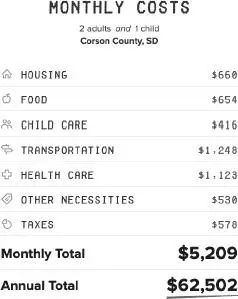Ellison works full-time as a clerk in the hospitality industry to support her family. “I’m really thankful for my employer because they do provide really good health insurance and a steady paycheck, and that’s what I need. It’s hard for a lot of people to find a job around here.” In 2016, 16.4% of the Standing Rock population earned less than $10,000 a year. 25As on other reservations, life expectancy and quality of life rates are among the lowest in the Western Hemisphere; Native children face premature death rates that are three to four times higher than the national average. 26
Ellison’s pre-tax income of $14,000 a year means she brings home just about $1,000 a month. She is well below the 2017 federal poverty line for a family of three set at $20,420. For comparison, the EPI self-sufficiency budget for a family of three living in Corson County, South Dakota is $62,502.

How does Ellison manage given the gap between $14,000 and $62,502? She depends on help from her family. Her salary covers the phone bill, half the electricity bill, heat, food, clothing and household items, the car payment, and baby expenses. In addition to having a husband who provides childcare, Ellison’s mom provides critical economic support: “My mom, even though she doesn’t live at our house, she still splits the bills with me and pays the rent.”
The arrival of her baby has had a big economic impact. Ellison tells me with some surprise: “Babies are really expensive!” The cost of raising children surprises a lot of people but no one more than new parents. They can count on spending about $200 a month on diapers, formula, and baby food alone. 27On top of basic expenses are the costs of clothing, furniture, a car seat, a stroller, childcare, and medical care. And the costs keep rising as children age. Ellison relies a lot on her family. “There’s a lot of single mothers here. I’m thankful that I have my husband, because he helps me so much. I don’t think I’d be able to do it as a single mom. We are just trying to get by, and that’s all we’re all really doing is getting by.”
When Ellison’s second child arrives, they will be a family of four, and in the best case her husband will continue to provide childcare, she will keep her job, and her mother will continue to help with family expenses. The best case means keeping already limited resources stable. The best case also means hoping that Ellison’s child will be born in good health and at a normal birth weight. 28Even if everything is the best case, life will become harder. This unexpected but very much wanted pregnancy will further strain already inadequate resources. The federal poverty line for a family of four in 2019 was $25,750. The EPI self-sufficiency budget for a family of four in Corson County, South Dakota was $74,098.
Ellison remains hopeful, pragmatic, and diligent. “A lot of the stuff I get is from rummage sales and [store] sales. I’ll wait until something goes on clearance before I get it, or I’ll wait so far along the line until it goes on sale vs. buying it at a high price, or I’ll order on Amazon, so I don’t have to waste gas. Because I live in a small town, I don’t have a whole lot of shopping options.” Without Amazon deliveries, Ellison would have to make the 160-mile round trip to Bismarck, North Dakota, to buy clothing and household items. It’s impossible to get anywhere without driving a considerable distance and this becomes an even bigger problem in the long and snowy North Dakota winters. 29The internet service that makes it possible for Ellison to buy goods online is provided by the reservation and is itself evidence of visionary leadership. Across the country nearly 15 million people live in sparsely populated rural communities with no access to a broadband internet service. 30

Like many people in struggling families, Ellison does not have a savings account. She tells me “I don’t even know how to save. I can’t save for my life, because we always need something. I always need something, whether it be an oil change, diapers, wipes, food. There’s always something.” It’s a daily struggle for her to sort out what they can and can’t afford, but even so, Ellison is quick to say that she has more privilege than others in her community. Not only does she have the support of her husband and mother – she also has a car. While you might be able to hitch a ride with a neighbor or friend to a grocery store, owning a vehicle is essential to holding a job. The distance between home and work can easily be thirty to forty miles one way.
Yet for low-wage workers owning a vehicle is a catch-22. “I have a vehicle that I’m paying off, so I have car payments that come out of my check,” explains Ellison. “The car is just really another baby. It’s equally as expensive to take care of.” The Dakota weather and the long-distance driving take their toll on vehicles. While Ellison is among the wealthier people on the reservation because she owns a vehicle, she can’t really afford to have something go wrong with her car. On Ellison’s budget there is no such thing as a small car repair. Even a small problem could start a cascade of events that will threaten both her budget and her livelihood. Worse yet, a mechanical breakdown would require a tow to a repair shop and leave Ellison with no way to get to work. With reduced work hours, it may take a while for her to be able to pay for the repairs – assuming she doesn’t get fired for missing work. “Even though some of us have more than others,” says Ellison, “we’re still struggling.” This is clearly true and, as Ellison points out, not everyone struggles in the same way.
Erika Brooks identifies herself as a member of the Standing Rock Sioux Tribe; she holds an associate degree and has worked her way up in Head Start from an initial position as an aide, to becoming a teacher, and then to her last position as a supervisor of several centers. She has traveled more widely than most people I meet. As a member of a religious organization, she traveled to Germany, Romania, and Russia doing service work. But when we met, a lot had already gone wrong in Erika’s life. When her siblings struggled with substance abuse issues, 31Erika came home to South Dakota to help with their children. For the last ten years she has been caring in some way for nine children, four of whom live with her. She arrived to meet me in a restaurant with the two youngest. Without romanticizing the challenges, she says the children give her life both meaning and satisfaction.
Now at age fifty, Erika is unemployed and filled with worry for the children. While she supports herself and four children on an income of less than $16,000, Erika never described herself as poor. “It’s pretty stressful, because we’re on a really limited income, but I make sure that, you know, we do everything on a tight budget so that we have enough.” In 2017, the federal poverty line for a family of five was $28,780. Like all federal calculations of poverty this number is completely unrealistic. In the same year, the EPI self-sufficiency budget for a family of five living in Corson County, South Dakota, was $82,524.
As seems obvious, Erika cannot afford childcare – actually, she can’t afford most of what is on the EPI self-sufficiency list. Several years back Erika was working full-time and living in an apartment in Mobridge. Things were good and she was able to help care for her family. “I was pretty involved with buying groceries for them and paying bills for them, along with my own bills, just doing that.” One day her sister brought her daughter to Erika’s apartment and said, “‘You can have her.’ And I said, ‘For the weekend?’ and she said, ‘No, you can have her,’ and I said, ‘You mean permanently she’s mine?’ She said, ‘Yeah, take her,’ and she had her clothes packed in a wagon. So, I kept her. I raised her.” That was eight years ago. Since then, three more nieces have come to live with her. It wasn’t easy, but Erika stretched to work full-time and care for the four girls. Then one day the new building manager asked her for paperwork that would prove she had legal custody of the girls. On the reservation, that would never happen. But she lived in Mobridge and now she was being asked by a non-Native building manager for custody papers.
Читать дальше














